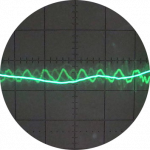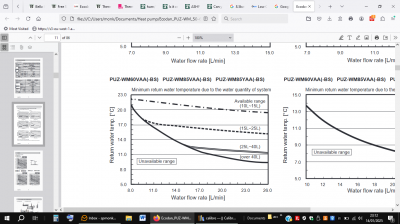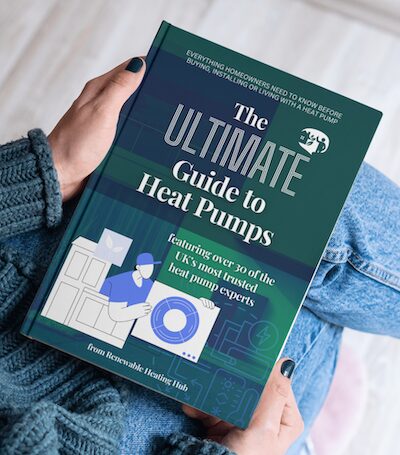hum/whine from Wilo circulation pump
Hello, very much a newbie here, and I don't know anything technical. I'd very much like to pick more knowledgeable brains!
We've had an ecodan 8.5kw heat pump installed for about a month, and are generally very pleased with it. However now that the weather is colder we have noticed a VERY annoying noise, especially when the frost cycle is running at night. It is a very quiet sound midway between a hum and a whine, (pitched at about 277 or 554 Hz - i can't tell the octave - if anyone is interested!), but despite the low volume it is intensely irritating and stops us sleeping. It appears to be coming from the circulating pump. Interestingly, in the airing cupboard where the circulating pump is situated the noise is much louder, but sounds more like a general pump noise. As you close the door and move away different frequencies seem to fall away and we're left with almost a pure tone. My husband says it sounds like motor noise.
We had the installer back for a couple of other issues so asked him about this, and he changed the pump setting from radiators (which we have) to underfloor heating (which we don't have) but this made no difference, and I don't really know why he did this. We have tried reducing the flow rate, this changes the pitch of the noise to something a little lower in tone but just as annoying.
We've bled the radiators a couple of times and the pressure seems fairly stable at about 1.2-1.3
The frost cycle is set to come on at 5 degrees. We keep the house fairly cool with thermostat set at 15 in the day, 16 in the evening and 14 overnight, which usually means no further heating is required till morning so it's really the frost cycle that causes the problem. The sound is still present intermittently during the day but is much less noticeable due to more general background noise in the house / outside
The circulating pump is a Wilo Yonos Pico 25/1-8
We have messaged the installer again, but would be very grateful for any suggestions on what we might do to remedy this.
Thanks
We have a Wilo Pico pump and when set to the ‘sweet spot’ is very quiet; I’m going to suggest that the problem may be with one of the radiator valves nearby. Has the system been balanced properly? (All TRV’s fully open and the lockshield valves gradually closed until the output of the individual radiators match the needs of the rooms.) [Please see
https://renewableheatinghub.co.uk/how-to-balance-radiators-the-role-of-the-lockshield-valve
for further enlightenment]
Are you using thermostatic radiator valves? A TRV can easily sit at just the wrong degree of closure and will ‘sing; until the conditions such as temperature change. The flow rate changing will influence the noise emanating from a TRV sometimes. I’m sure others will also have ideas for you. Regards, Toodles.
Toodles, heats his home with cold draughts and cooks food with magnets.
@toodles thank you for your input. We balanced it ourselves as best we could, but will have another go at it. However it is worst in a bedroom with the radiator permanently off, and in a cloakroom at the opposite end of the bungalow with the radiator fully on!
@grumpidoc do you have glycol in your system if so you can deactivate the frost protection mode so the pumps won't activate at night.
We do, tho I would need to check if the concentration is sufficient.
If we did that in this freezing weather would that mean the cooling fins on the outside unit would ice up?
And further question, sorry for my ignorance, I am aware turning it off overnight will make the heat pump work harder next morning when it's turned back on and that although that will reduce its efficiency it might not increase the total energy use, but would doing that regularly shorten the life of the ASHP?
Thanks
Although the primary pump installed on my EcoDan is not the same make as yours I had a similar issue - mostly solved by reducing the flow rate. The highest flow rate was not that much louder but it also created two frequencies that made the noise very unpleasant. It certainly seemed that one of other these penetrated the walls more readily and I was very aware if it at first - but that may diminish with time.
I hope your Wilco is more energy-efficient that the pump I have which has a box of electronics that gets stupidly hot. If your pump remains physically cool you could consider trying to muffle it.
The frost protection mode is about preventing pockets of water freezing and damaging the pipes. If you have glycol in the system then this is not a problem, so the protection mode is not required to run. If you have water only then you should know by the presence of anti-freeze valves on the external pipes close to the outdoor unit – the frost protection mode simply circulates the warm water in the insulated pipes to prevent these cold spots from building up. Icing of the fins is a cosequence of cold damp air when the HP fan is actually running.
Like many people I have two degree setback overnight and I think it may be better overall. Any setback effectively turns the pump off for a period of time, the entire length of the setback unless it is cold and the lower setting is reached during that period. The return to daytime temp is staggered so the algorithm is not set the problem of raising the house by two degrees at once which would cause it to work harder.
At temperatures when the pump is cycling rather than generating heat continuously, having this setback means that instead of cycling for six hours to maintain a consistent temp the pump works a bit harder but continuously for three or four, and that continuous run period is inherently more efficient.
Mitsubishi EcoDan 8.5 kW ASHP - radiators on a single loop
210l Mitsubishi solar tank
Solar thermal
3.94kW of PV
Posted by: @grumpidocwhich usually means no further heating is required till morning so it's really the frost cycle that causes the problem.
From your quote here I understood that the heat pump wasn't operating at night as you have the house quite cool. In the documentation you got from your installer it should state the temperature the glycol concentration was set at to protect, mine was -8C so depending on where you located its likely to be sufficient to turn it off completely.
Posted by: @grumpidocAnd further question, sorry for my ignorance, I am aware turning it off overnight will make the heat pump work harder next morning when it's turned back on and that although that will reduce its efficiency it might not increase the total energy use, but would doing that regularly shorten the life of the ASHP?
It won't work any harder than is currently does it will come on when your thermostat calls for heat you aren't changing that, as Harriup said icing only occurs when its running, cycling on and off multiple times an hour will shorten life of the compressor thats not the case here.
As mentioned pump speed could be a cause, if you go into service settings when the heat pump is running the heating and find the running information menu and input code 540 the number that comes on the screen is your flow rate in L/min for an 8.5KW Ecodan the recommended flow rate is 15.2L/min. If the flow rate is greater than that then you can turn it down. If you have an ecodan preplumbed cylinder this should be controlled from the main controller, in the same service menu go to pump speed and see what it is set at values are 1-5. Change it down a value and go back to the running information menu, code 540 and check what the new value is. Repeat until you are close to 15L/min. I find a setting of 2 gives me 14L/min and the best compromise between performance and noise.
Thank you @harriup and @gary this is all very helpful. The paperwork just states a rust inhibitor and 'antifreeze' and it looks like we have an anti-freeze valve. We've contacted the installers about the noise and they're checking with their tech team but if they don't have any other solution we'll talk to them both about adding glycol (can it be done after installation??)and about pump speed settings. They've been very responsive so we want to await their reply before doing anything.
We're working on balancing the radiators but it'll need to wait till it's not quite so cold to do it properly. All the radiators now have TRVs fully open and flow is controlled by the lockshield valves (we don't have an issue with solar gain etc in the winter!) The guide referenced by @toodles is really helpful.
Thank you all for helping! I'll update when we're sorted.
@grumpidoc I would still go into the menu when its running and check what the pump speed is set to and what the flow rate is, then you will have that info and know if you can turn it down. A lot of installers will set it at max and walk away.
@harriup and @gary finally got a moment to think about the pump - turns out the Wilo has a display which shows pump speed (though in cubic metres / hr). It was initially set to the equivalent of 35l/min which we have eased down to 27l / min. This has changed the pitch of the whine - it's now worse in the lounge (!) but gone from one bedroom so at least we have somewhere to sleep in peace. Please could you point me towards where to find the information about the recommended pump speed for the Ecodan 8.5Kw - I'm not doubting you at all, just wanting to know where to look for information! The only thing we could find was this graph in the service manual, which we couldn't really make sense of at all (hubby reckons we are on the 'over 40' line)
Please can I ask - what other effects turning the pump down further will have? I'm assuming it means the flow temperature will need to be higher, but will it affect things like the freeze stat?
In case it's relevant, I think our system may be oversized. To get the government grant it had to be sized to heat the whole bungalow to 21 degrees. However we like to keep 2 bedrooms cold, and we don't use the radiator in the conservatory (just wastes energy) or one of the two in the hall, (because if they are both on the hall is the hottest place in the home.) We will get around to properly balancing the radiators, we just haven't had a long enough chunk of time to spend doing it yet.
I think I need to ask more about the general running of the Ecodan, but I'll need to post a separate question after I've reread the book (From zero to heat pump zero)
Thank you all for your help
@grumpidoc Its from the mitsubishi databook see extract below
Do you have an Ecodan preplumbed cylinder or a different model, a picture of your cylinder would be good if its an ecodan cylinder then depending on your heating system there could be up to 4 pumps, 1 for primary flow from the heat pump, 1 for HW and 2 for heating zones.
Do you know which of these pumps is causing the noise?
If its the primary pump 27L/min is way in excess of the recommended flow rate of 15.2L/min.
15.2L/min is the flow rate you need to achieve the maximum output of and 8.5kW Ecodan.
Mass Flow rate = kW/ (4.2 x dT)
For an Ecodan ideal dT is 8
So to get 8.5kw of heat out of the unit the flow rate = 8.5/(4.2 x 8) = 15.2L/min.
-
Ideal Logic 10kW Heat Pump Pipes Noisy and Very Expensive to Run
10 months ago
-
Noisy Wilo Circulation Pump on Joule Preplumbed Cylinder
1 year ago
-
Ecodan - optimal external installation?
2 years ago
-
Planning Permission for Air Source Heat Pumps
5 years ago
-
Noise in garden from ASHP
5 years ago
- 26 Forums
- 2,360 Topics
- 53.5 K Posts
- 294 Online
- 6,026 Members
Join Us!
Worth Watching
Latest Posts
-

RE: My Powerwall 3 Consumes 3-4 kWh/Day in Self-Consumption: Is This Normal?
@caron, I'm looking into this for you... from my own pe...
By Mars , 41 minutes ago
-
RE: Mitsubishi Ecodan R290 10kW performance
@majordennisbloodnok Delat T 3C, no defrosting and I am...
By Ecoste , 1 hour ago
-
RE: New Fogstar 15.5kWh upright solution
SITREP #5 (I think) Milestone completed toda...
By GGW , 3 hours ago
-
RE: Octopus Cosy Heat Pump Owners & Discussion Thread
The FT levels off at either the set point OR the minimu...
By AndrewJ , 3 hours ago
-
RE: MyVaillant Connect Regular Disconnect
Thanks. Yes, if the time is consistently 11pm every nig...
By buckwem , 3 hours ago
-

RE: Speedcomfort radiator fans
My take on Speedcomfort radiator fans: If anyone w...
By Mars , 9 hours ago
-
RE: Midea ASHP – how to set weather compensation
@pash44pump I have yet to come across any Clivet or Mid...
By benson , 9 hours ago
-
RE: Who's your electricity provider and what's your tariff?
@transparent Thanks, this helps. Could it be that St...
By Batpred , 9 hours ago
-
RE: Clivet ASHPs and weather compensation
Simon did share a lot of very helpful advice. On furthe...
By ambris , 10 hours ago
-
RE: Home Assistant vs ESPAltherma.
@majordennisbloodnok Thanks very much.
By Ubert767 , 11 hours ago
-

RE: Setback savings - fact or fiction?
I could, but I think we can do better, by plotting hour...
By cathodeRay , 1 day ago
-
RE: Advice on internal circulation pump noise
Extend the primary branch and make sure you have more t...
By ASHP-BOBBA , 1 day ago
-

RE: External pipework insulation
Oh Dear! that's appalling pipe work, should've been in ...
By dgclimatecontrol , 1 day ago
-

RE: Jokes and fun posts about heat pumps and renewables
By Morgan , 1 day ago
-

RE: Controlling Daikin Altherma via P1P2 and Home Assistant
On the contrary, @toodles, that’s a lot of help. I’d ne...
By Majordennisbloodnok , 2 days ago
-

Parsnip, Bacon & Coconut Milk Soup
First let me say, I am only a cook because I am human a...
By Toodles , 2 days ago
-
RE: Electricity price predictions
Ben Watts posted on LinkedIn that he had updated this w...
By Judith , 2 days ago
-

RE: The good, the bad and the not that great – my heat pump installation
Small update, Emailed and Spoke to Midea UK and they ...
By Burtis , 2 days ago







